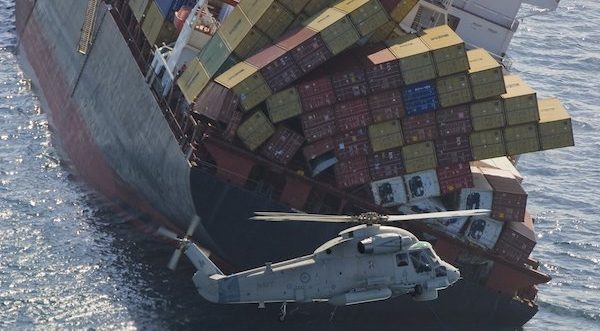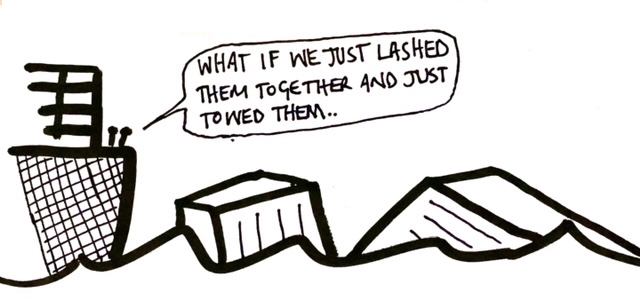Splash Extra: Why are so many boxes being lost at sea?

The 25th edition of Splash Extra launches on a day where yet another box spill accident is unfolding in the North Pacific, the fifth reported in the same area in just two months.
Why some 3,000 containers have been lost overboard in such a short timeframe occupies much of the January issue of Splash Extra. As well as looking at containership designs, lashing and stowage issues, the editorial team have conducted an extensive survey into the phenomenon of rogue waves, something that is especially problematic in the winter in the North Pacific.
The lead story in the subscription title looks at shipping’s newest trade – liquefied hydrogen (LH2) – with the world’s first LH2 carrier now operating and its backer, Kawasaki Heavy Industries, planning more ships, creating a new seaborne trade in a similar fashion to how it helped create the LNG trades more than 50 years ago.
Elsewhere there’s Splash Extra’s regular market commentaries, the best analyst comments of the month and an interview with John McCowan, a famous name in American container circles, who has just published a book called The Giants of the Seas.
Priced for as little as $200 a year, Splash Extra serves as a concise monthly snapshot, ensuring readers are on top of where the shipping markets are headed.
For more details on Splash Extra subscriptions, click here.


Weather routing (or lack of) and scheduling pressure as specific factors also mentioned?
Taking chances. A lot of pressure to save money and fuel.
The spate of container losses at sea has nothing to do with lashings or rogue waves. It is the pressure placed upon Masters of vessels by Owners, Operators and Charterers to meet schedules / ETA’s where the best weather weather route is not taken. By such Machiavellian commercial coercion the Masters judgement is compromised and safety of crew, vessel and cargo whilst said to take always precedence, doesn’t! The situation is exacerbated by current the enhanced container rates that has desk jockeys in front of their screens with their eyes of $$$ revolving like a fruit machine tumbler.
Spot on CAPTAIN!!!!!
Aloha Sam,
You’re making a great case for me to finally subscribe to the premium service.
I had a lengthy discussion with a friend who is a shipmaster that I have been working with for over 20 years. He has sailed aboard box ships most of his entire career (about 40 years), on US Flag ships. It was an enlightening conversation while we both waited for cargo operations to be completed on his containership yesterday.
He took me behind his chart table and showed me his ships BVS computer display (“Bon Voyage System”). I was stunned by this technology, that apparently has been out there for about a decade, but little mention of it (anywhere really) in articles about recent box-ship disasters. This computer ” … assists the ship’s officers by predicting the potential for severe motions by means of a tool for avoiding roll resonance and wave impact …” He says his entire fleet has this system and all Masters avail themselves to the information updated (from shore) typically every 6 to 12 hours. Depending on weather, he typically views this 2 or 3 times a day. During bad weather transpacific voyages from Asia to US West Coast, he literally sits in front of the display most of his waking hours.
He admitted the program requires some study and understanding to benefit from its use. He also said that after several years, you learn what to trust and have high confidence in, or not, from data to input. But the resultant output and display provides a shipmaster with the best course to steer (or ‘change to’) and/or speed adjustment. All this to avoid the worst of synchronous and parametric rolling. He has learned to take the recommendations and try them out and simply sit on the bridge for lengthy periods of time and observe the vessel’s change in motion and behavior. Once satisfied of positive improvement, he advises Mates to maintain that course and speed until more changes are needed.
The point is … there is existing technology to assist Masters in avoiding these boxes being lost over the side, much like the “Weather Routing” programs and subscriptions. But to be specifically clear, this system is independent of weather routing service. This BVS is in addition to being advised ‘where to go’ and is specific to the vessel’s loaded or ballast condition and and her physical motion at any moment in time. Newer ships even have accelerometers (motion detectors) mounted around the vessel to provide real time input. Perhaps its me, but little mention of these (or other similar systems) programs is ever seen in reports about these accidents. So I continuously wonder if these Captains on ships suffering huge losses of boxes over the side are using these systems, perhaps not correctly, or is there some other ‘disconnect’ that is occurring??? I can’t imagine these huge ships NOT having a BVS type system onboard.
Clearly this is a growing and more frequent problem with the advent of the modern Mega-Box ship. I believe most of us realize something needs to be done to address this issue. Meanwhile even more and bigger ships are being built and the insurance industry (and many other regulators) seem little interested in aggressively mandating positive changes towards container loss prevention.
Captain Ed Enos,
Good points.
Glad your illustrated some of the tools of the trade not known to many.
Thank You…
Captain Michael Mc Cright